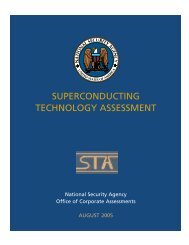Untitled - nitrd
Untitled - nitrd
Untitled - nitrd
- No tags were found...
Create successful ePaper yourself
Turn your PDF publications into a flip-book with our unique Google optimized e-Paper software.
PREPRINT COPYHardware and firmware security: Virtualization technologies (e.g., NSA’s Secure Virtual Platform); secureOS; encryption of data in memory; security processors; high-performance intrusion-detection technologies andtrusted platform modules – NSA, NSF, OSD, AFRLCryptography: Cryptographic algorithms and engineering for increasing network speeds; cryptographic keymanagement; quantum cryptographic methods and standards; quantum information science and security;quantum computation-resistant cryptography – NSA, NSF, DARPA, ONR, NISTApplied and information infrastructure securitySecurity management infrastructure: Policy-based access control systems; principles, frameworks, models, andmethods for identity, authentication, and privilege management in dynamic environments; management tools(threat analysis, attack- and risk-based decision models; survivability analysis framework; automated and realtimediagnostics for system security-policy flaws, configuration anomalies, vulnerabilities; ResiliencyEngineering Framework for assessing organizational security-management capabilities); next-generationbiometric measurements and standards – NSF, DARPA, OSD, AFRL, ARO, CERDEC, NSA, NISTCyber Conflict Defense S&T: Harden key networks and systems; assure missions; defenses to disruptadversaries’ cyber preparation and execution – DARPA, OSDAssured information sharing: DoD-wide priority to enhance technologies and tools to secure communicationsand data sharing across multiple, heterogeneous networks, platforms, and security levels; demonstrate securecollaboration through cyber sensing station – OSD and DoD Service research organizations, NSAInformation Security Automation Program (ISAP): Multiagency initiative to enable automation andstandardization of technical security operations; applying Security Content Automation Protocol (SCAP), amethod for using specific standards to enable automated vulnerability management, measurement, and policycompliance evaluation (e.g., FISMA compliance) – NIST, OSD, NSA, DHS, DISAMobile wireless and sensor networks: Security architectures for airborne/enclave networks, security ofclassified information on wireless networks; assured access anti-jam communications (physical layerinformation assurance); wireless, optical geolocation; trustworthy information delivery in mobile tacticalsystems (including sensor networks); secure handover for roaming between heterogeneous networks – NSF,DARPA, OSD, AFRL, ARO, NSA, NISTSituational awareness and responseNetwork protection and defense: Technologies and tools for situational awareness across organizations; threatanticipation and avoidance; attack sensing, warning, and response; cognitive policy-based intrusion protectionand detection; rapid response (containment, adaptation, repair, self-regeneration); behavior-based networkmonitoring and active defense; defense against large-scale attacks (e.g., DDoS, worms, botnets, spyware);routing security management tool; traceback, attribution, real-time forensics; prototype cyber operations center;security of emerging net-centric systems of systems and strategic computing resources – NSF, DARPA, OSD,AFRL, ARL, ARO, CERDEC, HPCMP, ONR, NSA, NIST, NASA, DHSInfrastructure R&DNational Cyber Range (NCR): Enable a revolution in the Nation’s ability to conduct cyber operations anddefend against cyber threats by providing a persistent cyber testing range – DARPAExperimental Research Testbed (DETER): experimental infrastructure to support next-generation cybersecurity technologies; allows repeatable medium-scale Internet emulation experiments – DHS, NSFInformation infrastructure security: Secure protocols; Domain Name System Security (DNSSEC); processcontrol systems security; Internet route monitoring; modeling of Internet attacks – NIST, DHS, GSA, OMBProtected Repository for the Defense of Infrastructure Against Cyber Threats (PREDICT): research datarepository to create and develop new models, technologies, and products to assess cyber threats to the country’scomputing infrastructure and increase cyber security capabilities – DHSStandards, testing, and metrics: Quantitative risk-analysis methods and tools; evidence-based security metrics;quantitative methods and tools to support cryptographic conformance determination and validation; models andstandards for protection, sharing of sensitive information; standards and tests to assess, validate systemsecurity; reliable information-assurance metrics; leadership in national and international standards bodies –NIST, NSF, OSD, ARL, ARO, DHSNITRD Supplement to the President’s FY 2010 Budget 7










